Top News
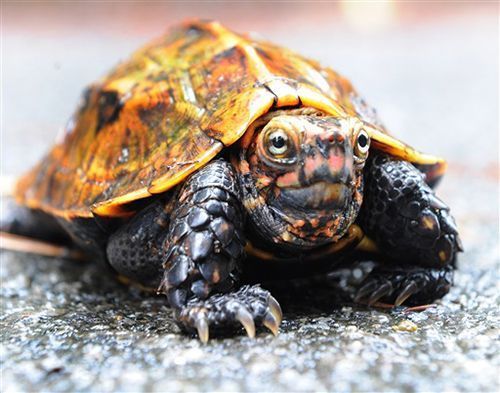
November 6, 2019 Ryukyu Shimpo
Okinawa – It was discovered November 5 that the Okinawa Zoo & Museum (Okihiro Kamizato, zoo director) was unable to locate 15 of nationally designated natural monument and endangered Ryukyu black-breasted turtle as well as 49 Chinese box turtles that were being raised at the zoo.
The zoo filed a police report with the Okinawa government office November 6.
The Ryukyu Shimpo similarly learned that the zoo was unsure of the whereabouts of a number of turtles in September of last year.
According to the zoo, at around 2:00 p.m. on October 28, one of the caretakers noticed a smaller-than-expected number of turtles at feeding time.
Upon inspecting the habitat, the caretaker noticed that a band securing the net over the habitat had been cut, and a portion of the net was removed. The zoo notified Okinawa City authorities, however as of November 5 a police report had not yet been filed.
The exhibit has been closed for the remaining nine Ryukyu black-breasted leaf turtles and fourteen Chinese box turtles since October 28.
The zoo said that the reason for not initially filing a police report was, “The person responsible [from the Okinawa City office] was out of the office for a few days, which overlapped with the holiday,” and commented, “We worry that [the turtles] will leave Okinawa island. We want cooperate in support of the police investigation.”
In the September incident last year, it could not be determined that a theft had taken place, and so a police report was not filed.
The zoo thereafter made changes to how they were exhibiting the habitat.
A representative from Okinawa City said, “We will confirm the circumstances surrounding the incident, and consider how to proceed after.”
The Ryukyu black-breasted leaf turtle is endemic to Okinawa’s main island as well as Toshiaki and Kume Islands.
Over fears of extinction, trade involving the turtle is restricted by the Washington Convention on International Trade in Endangered Species of Wild Fauna and Flora (CITES). The Chinese box turtle can be found on Iriomote and Ishigaki Islands in Okinawa, as well as in Taiwan and Southern China.
(English translation by T&CT and Sam Grieb)
Go To Japanese

November 4, 2019 Ryukyu Shimpo
Six dojos in Shuri, Naha gathered November 3 at the Sakiyama Park in Sakiyama, Shuri, where around seventy participants performed kata in a votive martial arts demonstration praying for the reconstruction of the recently burned down Shuri Castle.
The castle could be seen in behind the performers on the high ground of the park where they gallantly performed, hoping that Shuri Castle, the symbol of the place known as the birthplace of Karate, would shine once again.
Sakiyama Park was a martial arts appreciation and training ground, and there is an inscribed stone monument there denoting the birthplace of Karate.
With experiences such as the children from Shuri Dai-ichi Elementary school learned Karate in front of the castle’s main hall in 1938, Shuri Castle resonates deeply as the home of Karate.
There was even a martial arts demonstration planned for the upcoming Ryukyu Dynasty Festival.
The six Dojos participated at the request of the Shorin-ryu Shubukan. The children who regularly train at these dojos put their hearts into the kata as a way to encourage the people of Okinawa.
Shubukan master Yasuhiro Uema commented, “We held the event to lift the spirits of those who were grieving.
Shuri Castle has come to be known as the birthplace of Karate. I want to use Karate to give our strength to the Shuri Castle rebuilding effort.”
(English translation by T&CT and Sam Grieb)
Go To Japanese
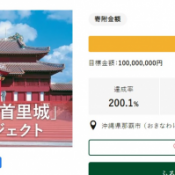
November 4, 2019 Ryukyu Shimpo
Following the Shuri Castle fire, the city of Naha set up a bilingual crowdfunding webpage—the Furusato Choice, which piggybacks on the nation-wide Hometown Tax Donation Program system.
The campaign has already collected over 200 million yen as of November 4, 1:13 p.m. The project met its goal of 100 million yen before 6 p.m. on November 3., but the donation further doubled in the following 19 hours.
The network of support continues to expand, as donations pour in with increasing momentum, in even greater amounts.
A representative for TRUSTBANK, Inc., which manages Furusato Choice, said: “The fund is growing at a very fast pace.
The contribution amount is increasing in million yen-increments every five minutes, which is astonishing.”
The cash amount per contribution has been generous, but the number of contributors is impressive as well, at around 14,000. Donations are coming in from all over Japan and from overseas.
The crowdfunding effort began at 2 p.m. on November 1, the day after the Shuri Castle fire.
It had met its goal on day three of the project, before 6 p.m. on November 3. An additional 100 million yen was donated in the next 19 hours, evidencing high levels of public interest.
As of 1:13 p.m., November 4, the project has raised 200,137,867 yen, thanks to its 14,082 contributors. Furusato Choice will continue to accept donations through March 31, 2020.
Click on the link below to donate today (English page):
https://www.furusato-tax.jp/gcf/717#2019_naha
*Update: As of November 7, more than 29,000 contributors have donated over 408 million yen to Furusato Choice.
(English translation by T&CT and Monica Shingaki)
Go To Japanese
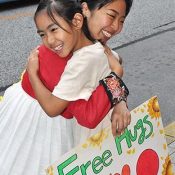
November 5, 2019 Ryukyu Shimpo
“The Japanese people I saw in the media and actual Japanese people are different,” says Su-yeon Yoon, who came to Japan as an exchange student and also worked at a hotel in Okinawa.
Yoon has been engaged in a free-hug campaign travelling through all the islands of Japan for the sake of Japan-Korea friendship. On November 4, she reached her goal at Kokusai Dori in Naha, where she hugged Okinawans walking down the street.
Yoon first started giving out free hugs in 2015.
The Korean media tended to show Japanese people engaging in hate speech and harboring anti-Korean sentiment, but “when I actually met [Japanese people], that wasn’t the case,” she says.
After that, she started giving out free hugs all over Japan on and off. Her most recent free hug campaign started in Hokkaido on October 19, and she visited a total of 15 locations.
Yoon marched down Kokusai Dori wearing a chima jeogori and holding signs saying, “I am Korean. Can I give you a hug?” and “Free Hugs for Japan-Korea Friendship.”
Sometimes Okinawans walking by and people who knew of her activities from SNS stopped to give her a hug.
Her former co-worker, Yu Miyahira, 21, said, “At work, having Yoon there made me feel motivated. Yoon is able to turn her words into action. I want to learn from her.”
At 6 p.m. on November 4, Yoon, having finished her free hug campaign, said, “I had the support of many Japanese people.
I think that an important thing for Japan-Korea relations is for us to convey our unaffected emotions.”
She emphasized the importance of human connection amidst what has been said to be the worst state of Japan-Korea relations since the end of World War II.
(English translation by T&CT and Sandi Aritza)
Go To Japanese
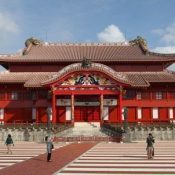
October 31, 2019 Ryukyu Shimpo
Shuri Castle was the principal castle of the Ryukyu Kingdom, and played a central role in Ryukyuan politics and culture for about 450 years, between 1429 and 1879.
According to Shurijo Castle Park’s official website, the grounds are largely divided into the inner and outer baileys, or wards.
The construction of the inner bailey was completed at the beginning of the 15th century, while the outer bailey was completed in the mid-16th century.

The main hall of Shuri Castle at the beginning of the Showa era.
The park’s official website further reveals that the castle served as a royal palace, where the Ryukyu King and his family resided, and housed the administrative body of the kingdom as the Shuri government head office.
It was also at the heart of a religious network of goddesses posted around the state, which conducted religious rituals for the King.
Furthermore, Shuri Castle was a cultural arts hub; Shuri Castle and its surrounding area boasted a robust music and performance arts scene, in which many fine artists and craft-persons actively produced work.
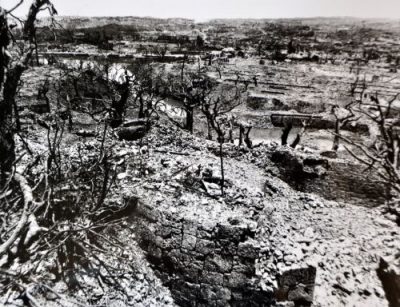
The remains of Shuri Castle photographed in 1945, after its destruction (photograph provided by the Okinawa Prefectural Archives.)
The Shuri Castle Seiden (the main hall) was designated a national treasure in 1925 as an Okinawan Shinto shrine, before burning down in 1945, during the Battle of Okinawa.
The site served as the University of the Ryukyus campus after World War II, but once the university moved to a different location, reconstruction of the castle commenced.
The reconstructed site opened its doors in 1992 as a government-managed park, in celebration of the 20th anniversary of Okinawa’s reversion to Japan.

The Shuri Castle served as a venue for the Kyushu-Okinawa G8 summit banquet in July 2000.
In December 2000, the Shuri Castle ruins became Japan’s 11th World Heritage Site, designated by UNESCO as “The Gusuku Sites and Related Properties of the Kingdom of Ryukyu”.
The same year, Shuri Castle served as a venue to the Kyushu-Okinawa G8 summit banquet. The Okinawan heritage site also appears in 2,000-yen notes.
Shuri Castle Park had become a top tourist destination in Okinawa among many tourists from Japan and abroad.
Every fall, the park recreated festive Ryukyu Kingdom rituals and ceremonies during the Shuri Castle Festival. This year, the festival kicked off on Oct. 27, scheduled through Nov. 3.
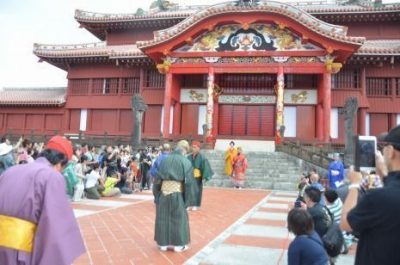
A recreation of a Ryukyu Kingdom ceremony at the Shuri Castle main hall in 2014.
(English translation by T&CT and Monica Shingaki)
Go To Japanese
November 1, 2019 Ryukyu Shimpo
Shuri Castle has burned down.
This treasure in the hearts of Okinawans which was rebuilt after its destruction in the Battle of Okinawa by the efforts of a large number of people committed to restoring the symbol of the Ryukyu Kingdom destroyed in the Battle of Okinawa, was reduced to ash in a single night.
This helpless scene has enveloped all of Okinawa in a grief as if they have been torn apart, and a sense of loss.
The loss of Okinawa’s greatest cultural asset is of incalculable magnitude.
However, we cannot be overcome with grief. In order to once again restore this vibrant crimson figure, Okinawans have to combine their strength to rebuild.
Shuri Castle, which embodied the history of the Ryukyu Kingdom, was the center of politics and culture as the seat of the emperor.
The main building was the center of diplomacy and trade for all of the countries in Asia as an independent country that had ties to all of the major powers in Asia, exemplified by the “Bridge of Nations Bell”, which has an inscription on the side that that includes the statement, “Journeying to various countries by ship, [the Ryukyu Kingdom] forms a bridge between all the nation, filling its land with the previous goods and products of foreign lands.”
More recently, it has passed through a history of hardships that includes the fall of the Ryukyu Kingdom.
In 1879, Michiyuki Matsuda sent soldiers from the Kumamoto Garrison to occupy Shuri Castle and expel the king of the Ryukyus, establishing the Kumamoto Garrison in the castle in the process.
Then, despite being designated a national treasure in 1925, in the 32nd Army of the Japanese Imperial Forces had established their command underneath the castle, which was then completely destroyed by U.S. bombardment during the Battle of Okinawa.
Restoring the lost cultural asset was a project that was met with a large number of difficulties.
Using documents and photos, the techniques of the time were recreated for each tile and pillar, and historians, artists, and engineers combined their wisdom to complete the restoration.
The rebuilding of Shuri Castle was recognized as the restoration of Okinawa history and culture by the people of Okinawa.
It strengthened the Uchinanchu identity, and was a source of pride. In 2000, the castle hosted a dinner for the G8, and was registered as a World Cultural Heritage site, announcing Okinawa’s bridge to the new generation to the international community.
The main hall, the southern and northern hall, and all of the major facilities have been lost to the fire.
What has become of the cultural assets that were exhibited there?
It is a grave concern. Okinawa had only just received permission from the Japanese government to manage the castle themselves in February.
It brings into question the responsibility of the prefecture.
What was the cause of the fire?
Were there deficiencies in the management conditions and fire prevention processes?
We must determine the cause of the fire as well as investigate how to prevent damage to cultural assets.
It is vital that we thoroughly investigate how to ensure that Okinawa’s precious cultural asset is not lost to fire a second time.
Including its destruction in the Battle of Okinawa, Shuri Castle has been destroyed four times throughout history. It has been rebuilt each time.
Thankfully, the successes of the previous restoration project, which began 30 years ago, remain.
If the system is set up properly, it is entirely possible that Shuri Castle can once again be resurrected.
When Notre Dame was similarly destroyed in a fire, and when Kumamoto Castle was destroyed in the Kumamoto earthquake, donations and support came pouring in almost immediately, and people set to work rebuilding. We can overcome the Shuri Castle fire this time as well.
(English translation by T&CT and Sam Grieb)
Go To Japanese
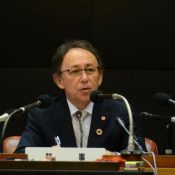
October 31, 2019 Ryukyu Shimpo online edition
In response to the Shuri Castle fire, the Okinawa prefectural government held a task force meeting on October 31 at the Prefectural Office.
Governor Denny Tamaki read out a message for the Okinawan people and made known his strong determination to restore Shuri Castle.
Governor Tamaki said, “We will do our utmost to restore Shuri Castle as soon as possible with the cooperation of the government, concerned organizations in Japan and abroad, the people of Okinawa, the people of Japan, and Uchinanchu around the world.”
Governor Tamaki also went to Tokyo on October 31.
On November 1 he requested cooperation with a status report in an interview with Chief Cabinet Secretary Yoshihide Suga at the prime minister’s official residence, in a visit to the Cabinet Office, and in a visit to the Ministry of Land, Infrastructure, Transport and Tourism.
Given that there are calls rolling in from Okinawa and overseas voicing the desire to aid in the restoration of Shuri Castle, the Okinawa prefectural government is working toward opening an account in preparation for contributions.
On October 31 Governor Tamaki cut his scheduled visit to South Korea short to return to Okinawa, and went directly to Shuri Castle shortly after noon.
Thereafter, Governor Tamaki summoned the heads of each department to form the Shuri Castle fire task force meeting in an endeavor to grasp the information available, and issued instructions to the Task Force so as to be prepared to the greatest degree possible.
The message Governor Tamaki read aloud to the Okinawan people contained the following statements: “The sense of loss enveloping [the Okinawan people] cannot be expressed in words, and there are many truly heartbreaking memories.
However, Shuri Castle is simultaneously a symbol of the Ryukyu Kingdom and adorns the heart of its history and culture.
The strong feeling that we must certainly restore [Shuri Castle] has boiled up”.
As concerns the heads of the Prefectural Office departments, the message states: “Approaching the sense of loss felt by Okinawans from all directions is crucial, I ask that we earnestly grapple with certainly putting [Shuri Castle] back up together.”
Moritake Tomikawa emphasized, “All Okinawans were shocked and stricken upon receiving [this news].
Shuri Castle is Okinawa’s identity and the heart of Okinawa’s spiritual culture. Uchinanchu from Okinawa, outside of Okinawa, and overseas are voicing their desire to help.
I hope the perspective that it is crucial to regain [what was lost] is widely received.”
After the task force meeting, Governor Tamaki held a press conference and said: “We must restore [Shuri Castle].
I humbly ask that many people lend their strength toward restoration. Okinawa Prefecture will grapple with this with complete devotion.”
The message for Okinawans that Governor Tamaki read aloud is as follows.
Around 2:47 a.m. this morning, fires broke out at the main temple of Shuri Castle among other structures.
Hereafter the sites of the fires will be inspected. The residents neighboring these fires, Okinawan citizens, and those in affected places were greatly troubled and think this is terribly regrettable.
Many lives were lost in the great battle in Okinawa, also lost were many valuable things including cultural heritage and documents, including Shuri Castle.
After the war, Okinawans wanted to restore Shuri Castle and many people also took up this helm.
These fastidious efforts took shape in Heisei 4, welcoming 20 years since the return [of Okinawa to Japan].
Now circumstances have turned back to those of bygone days.
Both the restored Shuri Castle and the one from the Ryukyu Kingdom era have come to be used for precious cultural assests in dyeing, weaving, lacquerware, and the like.
They are also known to many tourists as symbols of the historical/cultural journey of Ryukyu into Okinawa, and a foundation of Okinawan identity.
These fires burned down structures including Shuri Castle’s main temple right in front of our eyes, and many people are feeling great shock, starting with Okinawans.
Personally, I quickly canceled my schedule, including my sightseeing, business, and administrative visit to South Korea in order to return to Okinawa, and came directly to Shuri Castle to check the site of the fires.
The sense of loss enveloping [the Okinawan people] cannot be expressed in words, and there are many truly heartbreaking memories.
However, Shuri Castle is simultaneously a symbol of the Ryukyu Kingdom and adorns the heart of its history and culture.
The strong feeling that we must certainly restore [Shuri Castle] has boiled up.
We will do our utmost to restore Shuri Castle as soon as possible with the cooperation of the government, concerned organizations in Japan and abroad, the people of Okinawa, the people of Japan, and Uchinanchu around the world.
I earnestly ask for everyone’s understanding and cooperation.
(English translation by T&CT and Erin Jones)
Go To Japanese

October 31, 2019 Ryukyu Shimpo
At dawn on October 31, the fire broke out at the main hall of Shuri Castle or Shuri-jo castle in Naha City, Okinawa.
At 2:41 a.m., the Naha City Fire Department received a call about the fire from a security guard at the castle.
As of 7 a.m., the fire had not been extinguished.
The main hall and the north hall are almost completely burned out, and the fire spread to other buildings, such as the south hall.
About 40 fire-fighting vehicles were dispatched from the Naha City Fire Department and other area fire agencies to rush to the spot and douse the blaze. So far, there is no information about injured people.
The fire department is investigating the cause of the fire.
Naha City has been issuing warnings about the fires via the community wireless emergency alert system and public relations vehicles and is urging residents to close windows due to the possibility of fire sparks flying far away.
In addition, police tape is stretched around the castle and traffic restrictions are in place, and the prefectural police are calling for residents to evacuate.
Naha City has set up shelters at Jonan Elementary School, Shuri Community Center, and Ishimine Community Center.
Three people have been evacuated to the Ishimine Community Center. Naha City will hold the first meeting of the disaster warning headquarters at 7:30 a.m. on October 31.
Around 4:30 a.m., a sound like an explosion was heard, and the fire burned violently in the main hall of the castle, the apparent source of the fire, and smoke could be seen.
The fire is spreading over a wide area, with sparks reaching near the Hantagawa River more than 1 km away.
Takemasa Miyagi, 44, who lives near the castle, noticed the fire when he heard the sound of the siren and saw the sky stained red.
Miyagi said with unbelievable expression, “No one should be able to enter the main hall during night-time. Why? I’m just surprised.”
Shuri-jo castle was the central facility of the Ryukyu Kingdom for about 450 years from 1429 to 1879 and was the center of politics and culture.
It was designated as a national treasure in 1925 as an “Okinawa Shrine Hall”, but it was destroyed in the 1945 Battle of Okinawa.
After the war, the former site became the campus of the University of the Ryukyus, but after the university relocation, a restoration project was carried out.
It was restored as a national park in 1992 to commemorate the 20th anniversary of the Okinawa’s reversion to Japan.
In December 2000, Shuri Castle Ruins was registered as the 11th World Heritage Site in Japan as “Gusuku Sites and Related Properties of the Kingdom of Ryukyu”.
In the same year, a Social Dinner for the“G8 Kyushu/Okinawa Summit” was held.
The Shuri-jo castle attracts many tourists from Japan and overseas, now a leading tourist destination.
(English translation by T&CT)
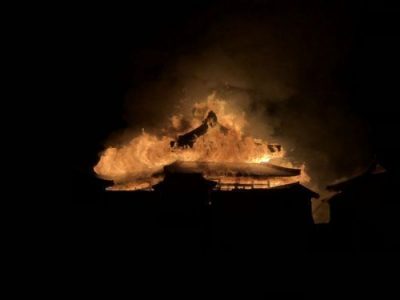
Burning Shuri Castle, Naha City, around 3:30 a.m. on October 31
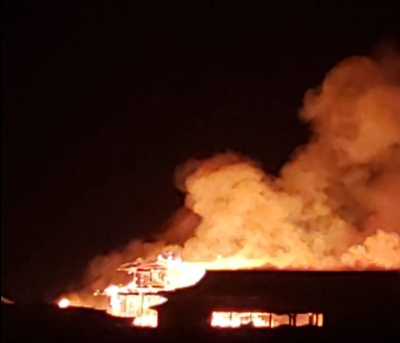
Shuri castle, where smoke rises from a severe fire

Firefighters giving instructions to extinguish fires, the main hall burned down with fire spreading to other buildings 4:30 a.m. on October 31, Naha City

Fire fighting vehicles gathered in front of Shureimon Gate, around 4:30 a.m. on October 31
Go To Japanese

October 28, 2019 Ryukyu Shimpo
Tsuyoshi Arakaki
Former Soviet Union President Mikhail Gorbachev, 88, who received the Nobel Peace Prize for his role in ending the Cold War, sat down with the Ryukyu Shimpo recently in Moscow for an exclusive interview.
When asked if he knew if the U.S. military had nuclear weapons in Okinawa from the reversion to Japan in 1972 through the end of the Cold War, he refrained from making a definitive statement, however he suggested the necessity for inspections, referencing former U.S. president Ronald Reagan, saying “Trust, but verify.”
The answer seemed to hint at his doubts around the denuclearization of the island after the reversion.
The U.S. was supposed to remove nuclear weapons from Okinawa at the time of the reversion, however during negotiations for the return of Okinawa, the U.S. included a clause in their written guarantee to abide by Japan’s three non-nuclear principles, stating, “that [Japan] would not check for nuclear weapons nor inspect storage facilities in Okinawa,” a term which the Japanese government at the time accepted.]
The denuclearization of Okinawa was objectively not verified.
Additionally, Gorbachev, who signed the Intermediate-Range Nuclear Forces (INF) Treaty with Reagan in 1987, noted that with the cancellation of the agreement on August 2, that there was the possibility that the U.S. would place intermediate-range missiles in Okinawa and other areas of Japan, commenting, “I feel the same way the citizens of Okinawa do,” indicating his deep concern.
Even though he is opposed to the deployment of these missiles, he suggested that Japan prepare themselves to inspect for the importation of nuclear devices.
He commented, “Okinawans fight for peace, and their opposition to the military bases is a thing worthy of respect.”
This is the first interview given by Gorbachev to the Japanese media since the annulment of the INF treaty.
Gorbachev noted that the annulment of the treaty, “is a manifestation of a dangerous and destructive trend,” indicating a sense of impending crisis.
He indicated that the context for the U.S. withdrawal from the treaty was, “an aim to achieve an absolute military superiority, even if it means removing all restrictions in the weapons field.”
He also criticized Trump’s nuclear armament expansion policy, “He is imposing his personal wishes on the world. However, this wish is a fantasy that will be impossible to realize.
The idea of a single hegemonic country in the modern world is impossible.”
Gorbachev predicted that the withdrawal from the treaty would lead to such situations as the destabilization of the global strategic balance, a new arms race, and greater chaos and unforeseeable situations in global politics, commenting, “It harms the safety of every country.
These spontaneously occurring links will lead to an out of control course.”
Furthermore, he stressed, “The key to solving security issues is not weapons, but politics.
This is an extremely important period in time. Excessive emotionality and propaganda need to be eliminated.”
He also called for the leaders of each of the major countries to “speak up in opposition to today’s status quo.”
He encouraged everyone, even ordinary citizens, to work together to push towards a more stable world order.
(English translation by T&CT and Sam Grieb)
Go To Japanese
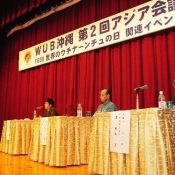
October 29, 2019 Ryukyu Shimpo
On October 28, just two days before “World Uchinanchu Day,” WUB Okinawa (Worldwide Uchinanchu Business Association Okinawa, chaired by Jinkichi Uezu) held its second Asia Conference at the Okinawa Harborview Hotel in Naha City.
Approximately 140 attendees, which included WUB Okinawa members, gathered to exchange opinions on Okinawa’s tourism.
Discussions drew comparisons with Hawaii, and explored potential areas of future development.
A panel discussion on “Okinawa and Asia’s mega-market” included OTS (Okinawa Tourist Service) Chair and CEO Yoshikazu Higashi, Okinawa Convention & Visitors Bureau Chair Yoshiro Shimoji and Toyo Keizai reporter, Hiroshi Matsuura. Higashi underscored the importance of shifting focus overseas, as Japan’s population is expected to shrink.
Shimoji touched on “Tourism EXPO Japan”, the world’s largest comprehensive tourism event—its 2020 expo will be held in Okinawa, and Shimoji highlighted the event as “a milestone for Okinawa in advancing its tourism.”
Matsuura offered a chronology of how prices on package tours to Guam and Saipan were cut, and warned that such a model “attracts undesirable tourists. We must practice caution not to repeat those same mistakes in Okinawa.”
(English translation by T&CT and Monica Shingaki)
Go To Japanese

October 24, 2019 Ryukyu Shimpo
On October 23, the “Okinawa Prefectural Butterfly” Selection and Advisory Committee held their second meeting at the prefectural office to decide on a prefectural butterfly that represents Okinawa Prefecture.
The committee decided on the Tree Nymph butterfly as their final candidate. The plan is to conduct a survey to collect public input next month.
Once the committee receives approval from Governor Denny Tamaki, the Tree Nymph butterfly will officially become the prefectural butterfly during this fiscal year.
This is the second case of a prefectural butterfly being established. The first being Saitama Prefecture.
According to a representative of the prefecture, candidates were evaluated based on four aspects, which were: 1) representation of a rich natural environment, 2) familiarity and popularity, 3) utilization for educational purposes, and 4) academic and and biological viewpoint (scarcity and uniqueness).
Tree Nymph butterflies are found throughout the entire prefecture, such as Okinawa, Miyako, and Ishigaki Islands. According to the representative, “It was unanimously decided since (the tree nymph butterfly) satisfies the selection criteria.”
Besides Committee Chairperson Kuniharu Miyagi, a total of four committee members from subjects, such as ecology, entomology, and forest ecology, attended the meeting.
In preparation for the establishment of a prefectural butterfly, the Prefectural Residents for Establishing Okinawa’s Prefectural Butterfly Association held a symposium in hopes of gathering momentum.
In 2017, the Tree Nymph butterfly came in first place among five candidates during the “Haberu General Election.”
Prefectural Residents for Establishing Okinawa’s Prefectural Butterfly Association Chairperson and Doctor of Agriculture Yasuhiro Ohshiro said, “Most of the prefectural residents were in favor of the Tree Nymph butterfly during the general election.
It must mean that it’s just that widely known and familiar. With this in mind, it would be nice if people pay more attention to other rare species as well.”
(English translation by T&CT and Chelsea Ashimine)
Go To Japanese


















 Webcam(Kokusai Street)
Webcam(Kokusai Street)


